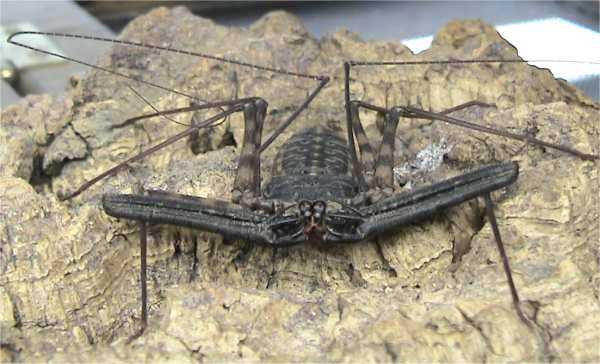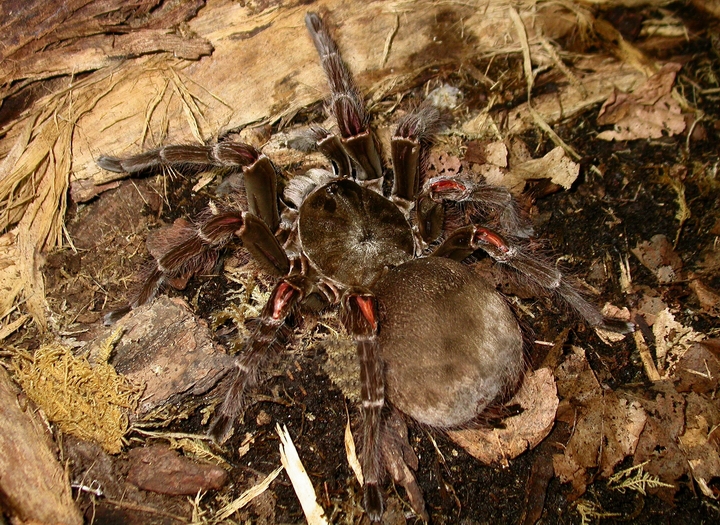 Having long worked with a variety of the world’s most unusual invertebrates, I had imagined myself ready for any and all surprises that might be offered by these fascinating creatures. Yet the first tailless whipscorpion that I encountered in the wild – a huge specimen that met my gaze inside a hollow tree in Venezuela (where I was searching for yet another bizarre beast, the giant vampire bat) – stopped me in my tracks.
Having long worked with a variety of the world’s most unusual invertebrates, I had imagined myself ready for any and all surprises that might be offered by these fascinating creatures. Yet the first tailless whipscorpion that I encountered in the wild – a huge specimen that met my gaze inside a hollow tree in Venezuela (where I was searching for yet another bizarre beast, the giant vampire bat) – stopped me in my tracks.
Although relatively harmless, these most unusual Arachnids certainly are formidable – some might say “nightmarish” – in appearance. If you are looking to add an animal that borders on the unbelievable to your collection, look no further than these fascinating spider relatives.
Description
Tailless whipscorpions are members of the Arachnid order Amblypygi, related to but distinct from the spiders and scorpions. The incredibly long front legs have evolved into sensory organs, and are slowly moved back and forth, touching this and that, as the animal senses its way about. It really is quite a sight to behold – one simply has no frame of reference, no matter how many odd creatures have crossed one’s path.
These specialized legs may cover a span of over 1 ½ feet. Some of the larger tropical species also sport 8 inch long “regular legs” and flattened bodies exceeding 2 inches in length – very impressive beasts over-all. Huge pinchers, kept close to the body until needed to grasp meals, add to the effect.
Tailless Whipscorpions in Captivity
The huge Tanzanian giant tailless whipscorpions (Damon variegatus and D. diadema), are becoming increasingly popular with invertebrate enthusiasts, with captive reproduction now regularly recorded. I have housed similarly-sized individuals in groups without incident, and was even successful in breeding them in this situation (I removed the youngsters to prevent predation).
In common with all related species, Tanzanian giants are arboreal, and need wide, flat climbing surfaces. Cork bark slabs are ideal. They should be provided a varied diet consisting of crickets, waxworms, roaches, locusts and wild caught insects.
All species kept to date require very damp conditions and temperatures of 72-76 F. Despite their tropical origins, tailless whipscorpions are most often found in caves, wells, hollow trees and other cool micro-habitats. Most fail to thrive if kept warmer than 80 F.
Although lacking venom glands, tailless whipscorpions can break the skin with their formidable front claws. For this reason, and because they move very quickly and shed legs easily, these odd creatures should not be handled.
Further Reading
You can learn more about the natural history of African tailless whipscorpions at http://www.arc.agric.za/home.asp?pid=4078.
Image referenced from Wikipedia and originally posted by Luis Fernandez Garcia
Reptile and amphibian keepers know how hard it is to find veterinary care for their pets, but those who keep scorpions face even greater difficulties. I found one or two vets willing to experiment while working at the Bronx Zoo, but in private practice your options are just about non-existent. What little we do know has resulted from trial and error, and is constantly evolving.
 That Reptile Blog – Reptile, Amphibian and Exotic Pet Care and Information
That Reptile Blog – Reptile, Amphibian and Exotic Pet Care and Information


 Although considered only mildly toxic, S. jendeki’s venom is quite complex, containing at least 19 different proteins. Scientists believe that these molecules may be useful in synthesizing new drugs. Newly discovered molecules, which may attack cells in novel ways, are always looked upon with great interest by medical researchers working with incurable diseases and drug-resistant microbes.
Although considered only mildly toxic, S. jendeki’s venom is quite complex, containing at least 19 different proteins. Scientists believe that these molecules may be useful in synthesizing new drugs. Newly discovered molecules, which may attack cells in novel ways, are always looked upon with great interest by medical researchers working with incurable diseases and drug-resistant microbes. Having long worked with a variety of the world’s most unusual invertebrates, I had imagined myself ready for any and all surprises that might be offered by these fascinating creatures. Yet the first tailless whipscorpion that I encountered in the wild – a huge specimen that met my gaze inside a hollow tree in Venezuela (where I was searching for yet another bizarre beast, the giant vampire bat) – stopped me in my tracks.
Having long worked with a variety of the world’s most unusual invertebrates, I had imagined myself ready for any and all surprises that might be offered by these fascinating creatures. Yet the first tailless whipscorpion that I encountered in the wild – a huge specimen that met my gaze inside a hollow tree in Venezuela (where I was searching for yet another bizarre beast, the giant vampire bat) – stopped me in my tracks.